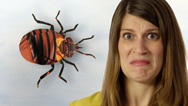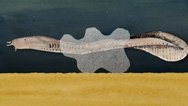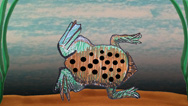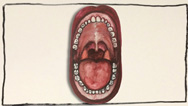Butt-less Cicadas
- By Anna Rothschild
- Posted 07.23.15
- NOVA
The fungus Massospora cicadina makes periodical cicadas’ butts fall off. Learn more in this episode of Gross Science.
Transcript
Butt-less Cicadas
Posted: July 2, 2015
Imagine if after a lifetime underground, you only had a few glorious weeks to live in the sun, eat, and mate… and then your butt fell off.
I’m Anna Rothschild, and this is Gross Science.
If you’ve ever been to the countryside in the eastern half of the US, you might have heard the buzz of cicadas in the air. And if you’ve seen my buddy Joe’s video over at It’s OK To Be Smart, you know that some of these gossamer-winged, singing insects called periodical cicadas are elusive—they only appear every 13 or 17 years, depending on the species.
Baby cicadas spend their long childhoods deep underground. If they’re lucky, they emerge after 13 or 17 years to spend their month-long adult lives drinking sap and procreating. But if they’re unlucky, they could spend those precious days sharing their body with a fungus that eats them from the inside out.
The fungus is called Massospora cicadina, and it specifically infects periodical cicadas. Its spores lie dormant near the surface of the soil, waiting for cicadas to start tunneling out of the ground. Then the spores invade the emerging cicadas’ abdomens and begin replicating. And when the insects start looking for love a few days later, they spread the fungus from cicada to cicada during their hour-long copulation sessions. Eventually, the fungus expands to such an extent that it splits the cicada’s abdomen open, causing its butt to fall right off.
Surprisingly, the cicadas don’t seem to mind. They carry on as they were, flying around and attempting to mate—which allows them to spread the fungus far and wide. One student who wrote a great article about this called these Massospora-infected cicadas “flying salt shakers of death.” Wherever they go, they sprinkle the soil underneath them with infected spores. And there, the fungus lies dormant—waiting for the next brood to emerge, 13 or 17 years later.
Now, just to be clear, there isn’t a rampant butt-exploding epidemic killing off periodical cicadas. Far more of them die from predation, and habitat disruption is a much bigger concern for these species. But every time these elusive creatures emerge, some of them fly around butt-less.
Ew.
Credits
PRODUCTION CREDITS:
- Host, Animator, Editor
- Anna Rothschild
- Writer, DP, Sound
- Rachel Becker
- Many thanks to Dr. Chris Simon, Dr. Michael J. Raupp, and Dr. Kimberly G. Smith.
- http://hydrodictyon.eeb.uconn.edu/projects/cicada/simon_lab/simonlab.php
http://bugoftheweek.com/thebugguy/
http://biology.uark.edu/1403.php - Rag Tag Rag
- Music Provided by APM
IMAGES
- Cicada photographs and footage
- Courtesy Michael J. Raupp, Professor at University of Maryland College Park
http://bugoftheweek.com/ - Magicicada young
- Wikimedia Commons/Arthur D. Guilani
SFX
- Cockroaches
- Freesound/StateAardvark
(used with permission from author) - Squeak Pack/squeak_10
- Freesound/Corsica_S
- A Magicicada chorus containing M. septendecim, M. cassini, and M. septendecula.
- Wikimedia Commons/Audio S4 from Fontaine K, Cooley J, Simon C (2007). “Evidence for Paternal Leakage in Hybrid Periodical Cicadas (Hemiptera: Magicicada spp.)” PLoS ONE.
- Produced by WGBH for PBS Digital Studios
IMAGE
- (main image: Massospora-infected cicada)
- Courtesy Michael J. Raupp
Sources
Want more info?
Angie Macias's “Flying Salt Shakers of Death” article, from the Cornell Mushroom Blog:
https://blog.mycology.cornell.edu/2013/02/19/flying-salt-shakers-of-death/
Massosspora Cicadina as a cicaca STD, from University of Maryland College Park Professor Michael Raupp:
http://bugoftheweek.com/blog/2013/6/17/std-in-cicada-land-imagicicadai-and-imassospora-cicadinai
An excellent review of all thing periodical cicada, fungal details on page 279:
http://hydrodictyon.eeb.uconn.edu/projects/cicada/resources/reprints/Williams%26Simon_1995.pdf
And here are some details about how these insects die:
http://cavern.uark.edu/~fstephen/new/Publications/articles/1993Williams.pdf
Related Links
-

Gross Science
Bizarre stories from the slimy, smelly, creepy world of science.
-

Hagfish Slime Fashion
Scientists think hagfish slime could be the next eco-friendly, high-performance material.
-

How Surinam Toads Give Birth
Surinam toad babies burst from the skin of their mother's back.
-

What Are Tonsil Stones?
If you’ve got white lumps in your throat, they could be tonsil stones or “tonsilloliths.”

